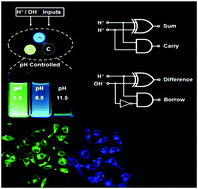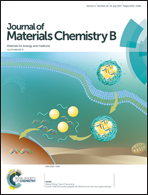Fluorescent carbon dots with tunable emission by dopamine for sensing of intracellular pH, elementary arithmetic operations and a living cell imaging based INHIBIT logic gate†
Abstract
Fluorescent carbon dots (C-dots) have drawn great attention in recent years, and many researchers have focused on developing preparation routes and broadening the applications of C-dots. In this work, novel luminescent C-dots with tunable emission were prepared by the pyrolysis of citric acid (CA) and dopamine (DA). By adjusting the molar ratio of CA and DA in the precursor from 2 : 1 to 2 : 3, the maximum fluorescence emission of the obtained C-dots is at 510 nm in acid solution, while it shifts to 450 nm under neutral conditions, and the fluorescence is quenched in a basic solution. By controlling the unique fluorescence emission at different pH values, a three-state switch is achieved. Half-addition and half-subtraction were performed at 525 nm and 450 nm emissions as outputs. And a living cell imaging based INHIBIT logic gate operation was achieved by imaging the channel ratio of the cells.



 Please wait while we load your content...
Please wait while we load your content...